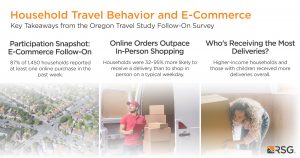Household travel surveys have long been essential tools for understanding how communities move: where people go, how they get there, and what influences their decisions along the way. But today’s transportation planners and policymakers face increasingly complex questions: What prevents people from traveling when they need to? How is online shopping reshaping local mobility patterns? And how can our data collection methods evolve to reflect the full range of modern travel behavior?
This article explores how combining quantitative household travel survey data, in-depth qualitative interviews, and targeted follow-on studies can reveal a more complete (and complex) picture of travel behavior in a region. Drawing on our team’s recent work in Oregon and across the United States, we examine how different data collection approaches can surface hidden barriers among the traveling public, quantify emerging trends like e-commerce, and support more equitable, data-driven transportation planning.
Qualitative Insights: Beyond the Numbers
Household travel surveys are proven tools for revealing how people travel. However, understanding foregone travel behavior, or travel not undertaken, is more challenging through conventional travel diaries alone. To explore this gap, a follow-on study conducted by RSG in collaboration with WestGroup Research supported the Oregon Modeling Statewide Collaborative (OMSC) to better understand foregone travel behavior among participants of the Oregon Travel Study (OTS).
Participants were recontacted based on factors such as low socioeconomic status, rural location, or other common barriers to transportation access (e.g., disability). By gathering 100 qualitative interviews with participants from these populations, the study aimed to deepen the understanding of decision-making in transportation. The findings, which are still being evaluated, support OMSC’s efforts to understand how household characteristics influence access and travel behavior, allowing for transportation planning decisions that consider equity and access gaps.

Insights into foregone travel behavior often begin where traditional data leaves off. In rural communities, lived experiences reveal the constraints, considerations, and trade-offs that shape whether (and how) people move through their environment.
Themes emerged in the interviews that could not be uncovered through quantitative data collection alone. Participants shared how their travel decisions were shaped by concerns about safety, proximity to transportation options, and economic limitations. They noted issues such as crime, poor lighting, unsafe driving conditions, and inadequate infrastructure as key deterrents to using public transit or active modes of transportation like walking or biking. Limited service frequency, long distances to transit stops, and high costs of alternatives such as taxis or ride-hailing services further limited mobility, especially in rural areas.
Caregivers and respondents with disabilities highlighted the need for better sidewalk access, curb ramps, and paratransit service. Parents expressed reluctance to use public transit with children due to concerns about safety and reliability. When combined with household travel survey data, these qualitative insights revealed a more comprehensive picture of actual and foregone travel behavior, supporting more inclusive and informed infrastructure decisions.
The Impact of E-Commerce on Regional Travel Patterns
The rise of e-commerce has reshaped how households interact with the transportation network. A multiregion analysis of household travel surveys explored how online shopping affects regional travel behavior and transportation demand.
E-commerce, which is broadly defined as shopping and exchanging services online, is popular among consumers for its convenience and efficiency. However, it increases delivery traffic to homes, workplaces, and other destinations. This adds complexity to transportation systems already managing congestion, accessibility issues, and shifting land use.
Using household travel survey data RSG collected using rMove® in Utah, Minnesota, North Carolina, and Washington, our team examined travel diaries in conjunction with delivery records. Each survey asked participants to log their trips and note deliveries received during the same period. This allowed our team to determine how often households were shopping in-person versus receiving deliveries on a typical weekday, and whether behaviors changed over time.

As online shopping becomes more embedded in daily life, delivery activity continues to reshape regional travel behavior. Understanding how and when deliveries occur, alongside in-person shopping trips, offers planners a more complete picture of household mobility patterns in the digital age.
The results showed no clear evidence that online shopping is replacing in-store shopping. In fact, online and in-person shopping behaviors often coexisted. Categories like groceries showed only a weak negative correlation, and for items like prescription drugs, there was no correlation at all. Households make purchasing decisions based on context and convenience, not necessarily as a one-to-one substitution.
Post-pandemic data revealed a notable shift: Households were between 32% and 95% more likely to receive a delivery on a typical weekday than to make an in-person shopping trip. Higher-income households and those with children received more deliveries overall, indicating a growing layer of demand on transportation networks.
Oregon’s Follow-On Travel Survey: E-Commerce and Access
To better understand how e-commerce affects household travel behavior, RSG worked with OMSC to incorporate a follow-on e-commerce survey into the OTS. This opt-in survey captured responses from 1,450 households, 87% of which reported making at least one online purchase in the past week.
Routine items like clothing, home goods, and pet supplies were more commonly purchased online than in-store. Major items and prescription medications were bought equally online and in-person, though infrequently. The survey found that households continued to prefer purchasing groceries and prepared meals in person.

Key takeaways from the Oregon Travel Study’s e-commerce follow-on survey highlight how delivery activity is reshaping household mobility patterns, and how these patterns vary by income and household composition.
These results suggest that analyzing e-commerce behavior by category provides valuable insight into which types of purchases may displace travel, and which do not. The OTS e-commerce follow-on survey is one of the first of its kind, setting a precedent for integrating e-commerce tracking into household travel data collection.
Using Data Collection to Support Transportation Planning
Combining comprehensive household travel surveys with qualitative interviews and e-commerce data offers a clearer view of how, when, and why people travel—or choose not to. This kind of multimodal, multimethod data collection helps planners understand behavior across a variety of demographics and regions.
People do not make transportation choices in isolation. Travel decisions are shaped by financial circumstances, caregiving roles, safety concerns, and digital alternatives like online shopping. Grounding transportation planning in holistic, representative travel behavior data allows decision-makers to address access gaps, design inclusive systems, and make confident, data-driven decisions.
·····························
Looking to create a transportation network that reflects how your community truly moves? RSG partners with agencies across the country to collect and analyze travel behavior using tools such as rMove®, the world’s most accurate approach to location-aware market research. Our deep expertise in survey-based research and custom follow-on studies, such as qualitative interviews and e-commerce surveys, offer the depth of insight needed to support actionable, data-driven transportation planning.




